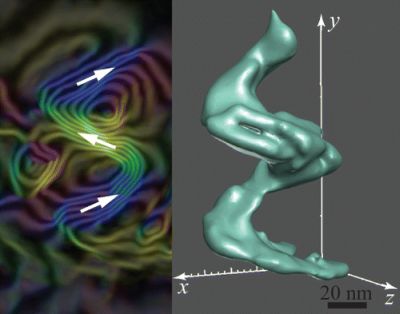Nanoscale three-dimensional (3D) structures are
building blocks for the fabrication of miniature switching devices and can be
used as functional units in nanorobotics. The functionality of the 3D
structures is affected by their size and shape and may significantly differ
depending on the properties of the bulk material. Nebraska MRSEC researchers
use deposition under oblique angles of incidence to produce manifold ensembles
of magnetic 3D nanostructures with different shapes and sizes, such as cobalt
nanospirals shown in the figure.
Collaboration with researchers from Argonne National Laboratory allowed
visualizing the magnetic domain structure of individual nanospirals, using
Lorentz transmission electron microscopy. The magnetic behavior was found to be
of single domain character along the spiral wire, with strong magnetic coupling
among the nanospirals due to an alternating direction of magnetization given by
the spatial geometry, and the close packed arrangement of the nanomagnets
within an array. The findings were recently published in Nano Letters, present the first observation of the complex magnetic
domain structure in 3D chiral nanoobjects, and are important for tailoring
nanomagnets towards their desired properties.

Magnetization map of a cobalt
nanospiral (left) showing variations in the magnetization direction (right).